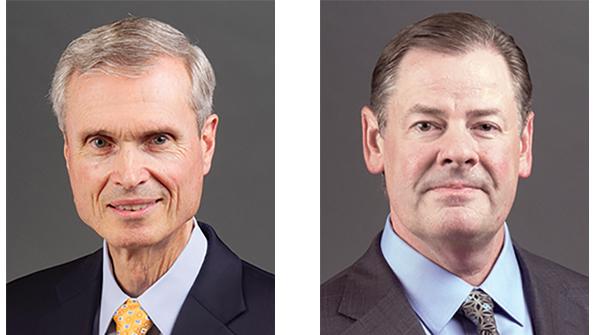Interview: Why Parker Hannifin Is Doubling Down On Aerospace

Parker Hannifin CEO Tom Williams (left) and Aerospace Group President Roger Sherrard
Coventry, England-based aerospace supplier Meggitt became part of Cleveland-based Parker Hannifin in September after the closing of a $7.3 billion acquisition that nearly doubled the size of Parker Aerospace. Parker Hannifin CEO Tom Williams and Aerospace Group President Roger Sherrard spoke with Aviation Week editors Joe Anselmo and Michael Bruno about the opportunities they see, while upholding promises made to maintain core Meggitt operations in the UK.
- Parker Aerospace doubles in size with Meggitt acquisition
- Latest move in yearslong rebalancing
- New heft provides aftermarket opportunities
AW&ST: How do you integrate Meggitt into Parker with the pledges you had to make to the British government?
Tom Williams: We’ve closed more than 80 transactions over the last 20 years, so we have a lot of experience with integration, especially in the last eight years of larger transactions. Many of them were international companies or had an international footprint.
If you look at Parker Hannifin, 35-40% of our sales and people are outside the U.S. We’re used to multicultural diversity. The commitments we made to the UK government were very natural and logical. We would have made them regardless of whether the government was involved, like honoring national security contracts, maintaining capabilities in the UK and continuing the center of excellence Meggitt built in Ansty Park [in Coventry]. We want to keep the engineers and the direct labor.
How will the Meggitt facilities fit into the Parker ecosystem?
Roger Sherrard: The Meggitt team, even though they’ve been around for 170 years, have really been just recently trying to create more processes. They’re probably about 15 years behind us in that regard, and that’s why we really think our strategy can help them. Bringing our processes into Meggitt to help accelerate some of the things they’re doing with financial performance, customer experience, engaging people and growth are all very aligned with our strategy. I think the big challenge is being able to double in size but still be agile by flattening out the organization. The Meggitt team is very open to that. They look at Parker Aerospace and see the success we’ve had over the last six or seven years. And it’s no secret they’ve struggled. I really think that the two companies together are not just a doubling in size and adjacent products. Now both engineering teams can solve problems for customers. And being much larger, we’re on the radar screens of big customers.
Is the dramatic strengthening of the U.S. dollar against the UK pound affecting your deal?
Williams: We took that risk off the table from the beginning of the transaction. When we first took out the financing, we did a deal-contingent hedge, which guaranteed a certain rate. Also, when you look at Meggitt, about 70% of their revenues are in U.S. dollars. Roughly half of their business—people, facilities, etc.—is in the United States.
How does this combination change the role of aerospace within Parker Hannifin?
Williams: We want to be the consolidator of choice where we can be the best owner of the technology. If you think about all the motion control technologies that are going into things that fly, mobile equipment, industrial or life sciences equipment, it’s roughly a $135 billion space. We’re leveraging the same suite of technologies across [multiple] sectors. We’ve always liked aerospace. Two of our last four deals were aerospace properties, one in filtration and one in engineering materials. We would like to continue to build out aerospace.
Sherrard: We’ve been working on transforming our aerospace portfolio for years, rebalancing into more engine exposure, where we love the aftermarket. We were a little bit overweight on airframes, so that’s what Exotic [Metals Forming, acquired by Parker Hannifin in 2019 for $1.7 billion] did for us. We’d always been looking to partner with Meggitt. We were meeting with them seven or eight years ago.
How will Parker and Meggitt leverage each other’s capabilities?
Sherrard: Meggitt really didn’t have a team to do polymers and composites, but Parker Hannifin has a whole business with our Engineered Materials Group, so we immediately teamed them up. That’s going to fundamentally change the trajectory of those businesses. In clean technologies, Meggitt can help with advanced sensing for engine controls. We’re both investing in more electric aircraft in different areas and higher-temperature heat loads. They have thermal management capabilities. There are things like climate-friendly fire-suppression systems and investments for hydrogen and sustainable aviation fuel. In the commercial aftermarket, we’re approaching the significant threshold where we can take a different posture service-wise and create a much more compelling value proposition for airlines around the world because we’re larger.
When should we expect Parker to make more aerospace acquisitions?
Williams: In the near term, growth will be more organic because we need to pay the balance sheet down. But longer term, we’ll look at both inorganic and organic acquisition candidates. Parker Aerospace and Meggitt will have a very nice growth rate when you go out 5-10 years, and we have the opportunity to add on to it with acquisitions. With the portfolio changes and the trends around aerospace—digital, clean technology, electrification—the company is becoming much more long-cycle. About 85% of our company is either long-cycle or aftermarket. So the company is going to grow a lot differently compared to the last 10 years.






